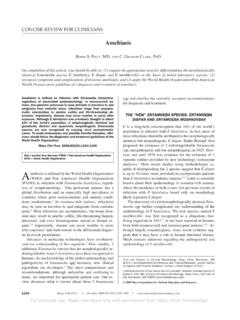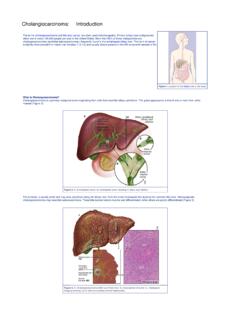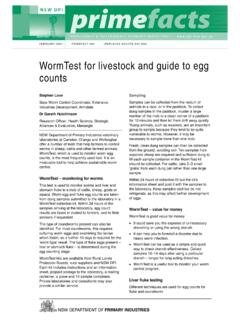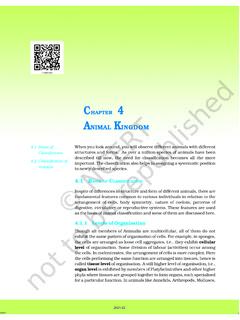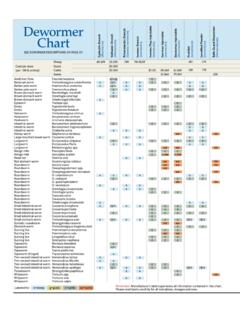Transcription of Helminths (Parasitic worms) - bio.umass.edu
1 1 Helminths (Parasitic worms) Kingdom Animalia Phylum Nematoda Phylum Platyhelminths Flatworms Roundworms Multicellular - tissues & organs Degenerate digestive system Reduced nervous system Complex reproductive system - main physiology Complex life cycles Helminths - Important Features Significant variation in size Millimeters to Meters in length Nearly world-wide distribution Long persistence of helminth parasites in host PUBLIC HEALTH Indistinct clinical syndromes Protective immunity is acquired only after many years (decades) Poly-parasitism Greatest burden is in children Malnutrition, growth/development retardation, decreased work Morbidity proportional to worm load Helminths (Parasitic worms) Kingdom Animalia Phylum Nematoda Phylum Platyhelminths Digenetic Flukes Tapeworms Cestodes Trematodes Free-living worms Tubellarians Monogenetic Flukes Monogenea 2 Phylum Platyhelminths General Properties (some variations) Bilateral symmetry Generally dorsoventrally flattened Body having 3 layers of tissues with organs and organelles Body contains no internal cavity (acoelomate) Possesses a blind gut ( it has a mouth but no anus)
2 Protonephridial excretory organs instead of an anus Nervous system of longitudinal fibers rather than a net Reproduction mostly sexual as hermaphrodites Some species occur in all major habitats, including many as parasites of other animals. Planaria - Newest model system? Planaria - common name Free-living flatworm Simple organ system RNAi - yes! Large scale RNAi screen Amazing power to regenerate Neoblasts - stem cell-like Stem cell regulation Nervous system regeneration Only neoblasts proliferate Planaria Diversity 3 Helminths (Parasitic worms) Kingdom Animalia Phylum Nematoda Phylum Platyhelminths Digenetic Flukes Tapeworms Cestodes Trematodes Free-living worms Tubellarians Monogenetic Flukes Monogenea Evolutionary Relationships Evolution of Parasitism Monogeneans Separate branch Trematodes/Cestodes Separate branch Sister clades Simplified Form and Function Tegument provides protection and gas exchange - a living tissue not just a covering Musculature - layer beneath the tegument Movement and feeding Circular, longitudinal, diagonal Digestive system - branched, no anus Nervous system - orthogon or ladder-like Longitudinal nerve cords.
3 Lateral branching Reproductive organs - hermaphrodites Female - 1 ovary, vitelline gland (yolk) Male - testis, seminal vesicle Genital pores open into a genital atrium 4 Monogeneans Taxonomy still controversial Look similar to Digenetic flukes Ectoparasites - mm - 20 mm Gills or body of fish - a few occur on amphibians & reptiles Large holdfast organ at posterior end Haptor - may have hooks May also have holdfast organ at anterior end Prohaptor Monogenean Life Cycle Not well understood Direct development Monogenean = 1 generation 1 egg = 1 adult Single host Niche specificity as well Eggs contain long filaments Eggs hatch in the water Hatching releases an oncomiracidium that is ciliated Egg laying usually coincides with breeding season of host
4 Oncomiracidium Short-lived form - free swimming Monogeneans Generally non-pathogenic infections Crowded conditions will promote higher parasite # s Some economically important Fish hatcheries - large die-offs Attachment to gill filaments - loss of blood, epidermis, increase in bacterial infections Hermaphroditic Cross fertilization vs. self Diplozoon juvenilles will fuse and this promotes maturation of reproductive tissues (Cross) Dactylogyrus sp. Diplozoon paradoxum 5 Helminths (Parasitic worms) Kingdom Animalia Phylum Nematoda Phylum Platyhelminths Digenetic Flukes Tapeworms Cestodes Trematodes Free-living worms Tubellarians Monogenetic Flukes Monogenea Trematodes - Flukes Digenean (di = two) (genea = beginnings) Flat, leaf-like structure Ventral and oral sucker Obtain food by absorption through cuticle (tegument)
5 Hermaphroditic and separate sexes Tissue Flukes Clonorchis sinensis Fasciola hepatica Paragonimus westermani Blood Flukes Schistosoma mansoni Schistosoma haematobium Schistosoma japonicum General Trematode Life Cycle Adult Egg Miracidium Sporocyst Metacercaria Cercaria Daughter Sporocyst or Redia Asexual reproduction Transmission Sexual reproduction 6 Life Cycle Terminology Egg = shelled embryo Operculum cap - lid-like specialization May need to embryonate Water - avoid dessication Temperature is important Eggs are killed by freezing Eggs hatch - release miracidium Most just require water Others hatch only when eaten by suitable host Miracidium - ciliated larval stage Very active free-swimming form Seek out intermediate host (molluscs) Penetrates tissue with auger like motion - about 30 sec to penetrate!
6 Life Cycle Terminology Sporocyst Develops in Molluscan host Hollow fluid filled sac of embryos Contains a birth pore at anterior end No mouth or digestive system - absorbs nutrients Differences here depending on species Daughter sporocyst Redia Cercaria Redia - 2nd larval form in Mollusc Burst out of the sporocyst More active form, posses a simple gut Mouth, and birth pore @ anterior end Develop into cercaria Life Cycle Terminology Cercaria - very small Leaves the snail to find the next host Looks like a miniature adult with a tail Utilizes tail for swimming, and will lose it as it penetrates the next host Metacercaria Infective stage for the definitive host Resting stage in the life cycle Miniature adult curled up inside a tissue cyst Waiting for intermediate host to be eaten by definitive host.
7 7 Adult Internal Structures Simplified Form and Function Tegument Digestive Excretory Female Reproductive Male Reproductive The Tegument - a syncytium Poor in organelles; syncytium with cytoplasmic connections with underlying nucleated cell bodies The outer surface has folds and is pitted with numerous opening of tubular canals Underlying the tegument is a basal lamina from which mitrotubules extend into the tegumentary matrix The gut IS NOT the only organ for nutrient uptake! Tegument - highly active in nutrient uptake Epidermis is basically a single cell - syncytium - fusion of many cells epidermis 8 Trematodes of Medical Importance Clonorchis sinensis Chinese liver fluke Geographic Distribution Japan, Korea, China, Taiwan, and Vietnam.
8 Also found around China Towns in the Approximately million infected worldwide Definitive Host - Humans, pigs, dogs, cats, rats, camels First intermediate Host freshwater snails Second intermediate Host - freshwater fish (mainly carp and crayfish) Clonorchis sinensis Life Cycle Diagnostic stage Adult worm Sporocysts Cercariae liver Ingestion of raw or undercooked metaercariae Infectious stage 9 Clonorchis sinensis Pathology Light Infection Common, asymptomatic, mild indigestion, upper right abdominal pain Heavy Infection (>200 worms) Abdominal pain, diarrhea, anorexia, hepatomegaly, abdominal tenderness, jaundice Chronic Infection liver cancer Treatment Praziquantel Albendazole Flukes in bile duct - thickening of wall liver cancer from heavy infestation Family Fasciolidae Mainly parasites of herbivores Fasciola hepatica - liver Fasciola gigantica - liver Fasciolopsis buski - intestinal One of the largest trematodes found in humans!
9 Cone-nosed cm Fasciolopsis buski - intestinal fluke Definitive Hosts: Humans and Pigs First Intermediate Hosts: Aquatic snails, particularly Segmentina and Hippeutis. Second Intermediate Host: Aquatic (freshwater) vegetation, including water chestnuts, water caltrope, lotus, and bamboo. Geographic Distribution: Mainly Orient. About 10 million people are infected. Transmission to : Ingestion of metacercaria on vegetation. Location in : Small Intestines. Each worm can produce 25,000 egg/day! 10 Pathology Pathology: Generally very little. Attachment sites can ulcerate, and worms may obstruct small intestines and interfere with food absorption. Absorption of worm waste results in verminous intoxication similar to tapeworms.
10 Symptoms: Depends on the number of worms (worm burden). Can include nausea and chronic diarrhea. Fasciola hepatica - liver fluke Definitive Host: Herbivorous mammals, occasionally humans First intermediate Host: aquatic snails Second intermediate Host: Metacercaria form on aquatic plants Geographic Distribution: Cosmopolitan. Very common in western livestock. About million humans worldwide are infected. Transmission to : Ingestion of metacercaria. Human infections usually come from ingestion in water or on water cress. Location in Definitive Host: liver , particularly bile duct. Disease Pathology Disease: first described as liver rot Human infection is common in Europe, Africa, S.

